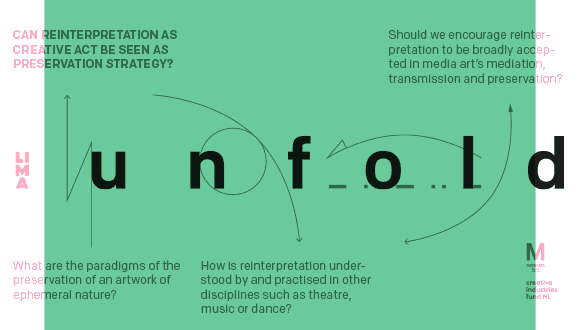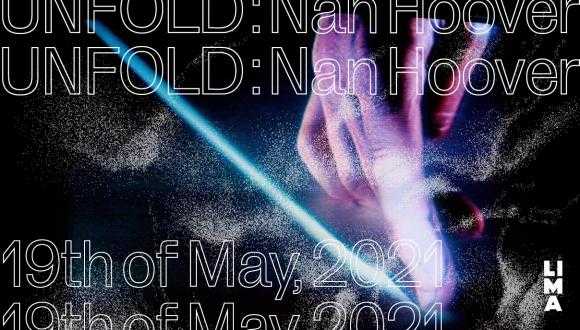UNFOLD Session #3
Reinterpreting the digital.
Within the context of the UNFOLD research project, LI-MA organised the public event: UNFOLD #3 Reinterpreting the digital and an expert meeting on 1 December 2016. The third expert meeting presentation sought to answer the following question: Should we encourage reinterpretation to be broadly accepted in media art’s mediation, transmission and preservation?
Participants
- Maaike Bleeker (professor of Theatre Studies in the Department of Media & Culture Studies at Utrecht University
- Jan Robert Leegte (artist)
- Sanneke Stigter (assistant Professor in Conservation and Restoration of Cultural Heritage at the University of Amsterdam)
- Serena Cangiano (artist)
Summary
An expert meeting was held on 1 December 2016, concentrating on the consequences of using, as a mode of mediation, the act of reinterpretation. The key lecturers, theatre studies professor Maaike Bleeker, artist Jan Robert Leegte, and conservator Sanneke Stigter, with a skype intervention by curator Serena Cangiano, were invited to have a closer look into the politics of preservation when talking about reinterpretation. By doing so, we were able to discuss the importance and influence of institutional protocols when talking about reinterpretation and its relation to notions such as the author, the original, or the ethics of preservation. Furthermore, as indicated above, one main question guided this third phase of the project: Should we encourage reinterpretation to be broadly accepted in media art’s mediation, transmission and preservation?
As briefly indicated in section 2.1 of this text when referring to the incorporation of discourses coming from performance studies, and especially that of Diana Taylor, Bleeker also incorporated during her intervention Taylor’s distinction between archive and repertoire. The repertoire of embodied memory –conveyed in gestures, the spoken word, movement, dance, song, and other performances – is discussed by Taylor as a proposition for alternative perspectives to those derived from the written archive and particularly useful for a reconsideration of historical processes of transnational contact. The archive is thus understood as a tool to investigate the past, to go backwards, while repertoire brings the past into a live present; that is, repertoire has a “futureorientedness.” Bleeker proposes thinking about the choreographic object as an abstraction that is not limited to a particular ‘materialisation’, but open to infinite potential materialisations.
Artist Jan Robert Leegte, in that sense, suggested during his intervention to approach reinterpretation as a tool for ‘rooting’ a way of thinking in relation to the digital: a possible way to emancipate the platform of the digital. Reinterpretation as an artistic method is able to zoom in on specific aspects of a piece and how those could be contextualised in a new digital context. In a sense, Leegte proposes the idea of reinterpretation as a "revision", which highlights the importance of understanding the ambivalence of materiality within digital media platforms.
Curator Serena Cangiano proposes that we differentiate between the strategy of open reprogramming and the re-making. In her own words “every remake based on new technologies and new materials entails a radical process of re-design. While on one hand this strategy betrays the uniqueness and originality of the artwork, on the other it answers new questions concerning the conservation of kinetic end interactive artworks that cannot be simply contemplated, but call for active audience participation.” Cangiano shares with us how, after a weeklong workshop in which they spent translating and subverting the artistic concepts of Gruppo T’s work, they “realized that applying the new paradigms of collaborative development, augmented by the Internet, helped [them] to understand how to achieve the distributed, everyday aesthetic action that was part of the Gruppo T’s utopia (so the artists’ intentions).” Through the open making of derivative works, they “learned how to liberate the artwork and to ensure that it lives on: once it is part of the commons, it is not a case of granting everyone the right to reproduce it, but rather conferring the responsibility to preserve its essence. That is the main benefit of open sourcing projects, processes and artworks.”
While Cangiano proposed open sourcing as preservation strategy, and how the method of re-enacting practices rather than the remaking of artworks activates an exchange of knowledge, conservator Sanneke Stigter made us reflect about the act of conservation per se, its ethics, its constraints and politics. To do so, Stigter discussed ethnography as a research method in museums. She compared her method of autoethnography to Vivian van Saaze’s “participatory observation” – in Installation Art and the Museum (2013) – and Glenn Wharton’s “participatory action research”, in The Painted King (2012). From a conservator's perspective, Stigter observed, the act of reinstallation could be understood as a possible act of reinterpretation. Interestingly, Stigter suggests how reinterpretation allows preservation to happen within the creative process.








